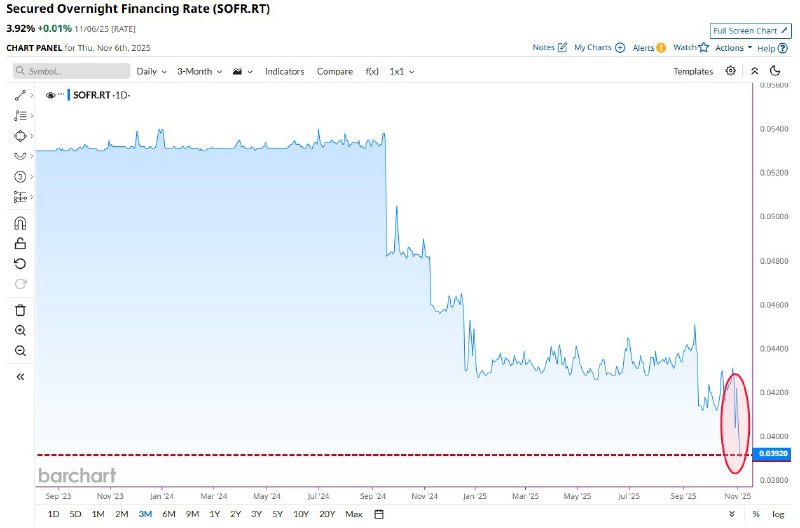The Secured Overnight Financing Rate (SOFR) fell sharply to about 0.0835% on November 6, 2025, reaching its lowest level in more than two years. The sudden drop in the key U.S. dollar funding benchmark underscores a notable easing in short-term liquidity conditions that could ripple through traditional markets and the cryptocurrency ecosystem.
Key Developments
- SOFR—the broad measure of the cost to borrow cash overnight collateralized by U.S. Treasuries—declined to approximately 0.0835%, marking a more-than-two-year low.
- Chart data highlights a sharp intraday move leading into the latest print on Nov 6, 2025.
- The decline suggests a shift in dollar funding dynamics, potentially tied to market liquidity changes or central bank operations.
Why SOFR Matters
SOFR is a foundational benchmark for dollar financing across global markets, replacing LIBOR and influencing costs for loans, derivatives, and repo transactions. Because it reflects conditions in the Treasury-backed repo market, moves in SOFR can signal broader shifts in liquidity.
- Lower secured funding costs can reduce borrowing expenses for institutions active in fixed income and derivatives.
- In digital assets, crypto market makers and lenders that interface with dollar funding or Treasury-backed collateral may see knock-on effects in liquidity and basis trades.
- While crypto perpetual swap funding rates are set by exchange mechanisms, macro funding conditions often shape risk appetite and cross-market positioning.
For reference, background on SOFR methodology is maintained by the Federal Reserve Bank of New York.
Market Impact
- A softer SOFR typically points to easier short-term financing, which can support risk assets if conditions persist.
- Crypto participants attentive to macro liquidity—particularly those running arbitrage, basis, or collateralized lending strategies—may adjust exposures as funding spreads shift.
- If the move reflects transitory technicals (e.g., collateral imbalances or bill supply dynamics), effects could be short-lived; a structural easing would have broader duration.
What to Watch Next
- Upcoming SOFR prints to confirm whether the decline persists or reverses.
- Treasury cash and bill issuance patterns that can tighten or loosen repo markets.
- Central bank operations and guidance that may influence money market liquidity.
- Changes in crypto derivatives open interest and funding, which often react to shifts in macro financing conditions.
In the near term, traders across traditional and digital assets will monitor whether the latest SOFR downdraft marks a temporary dislocation or the start of more durable easing in dollar funding.
